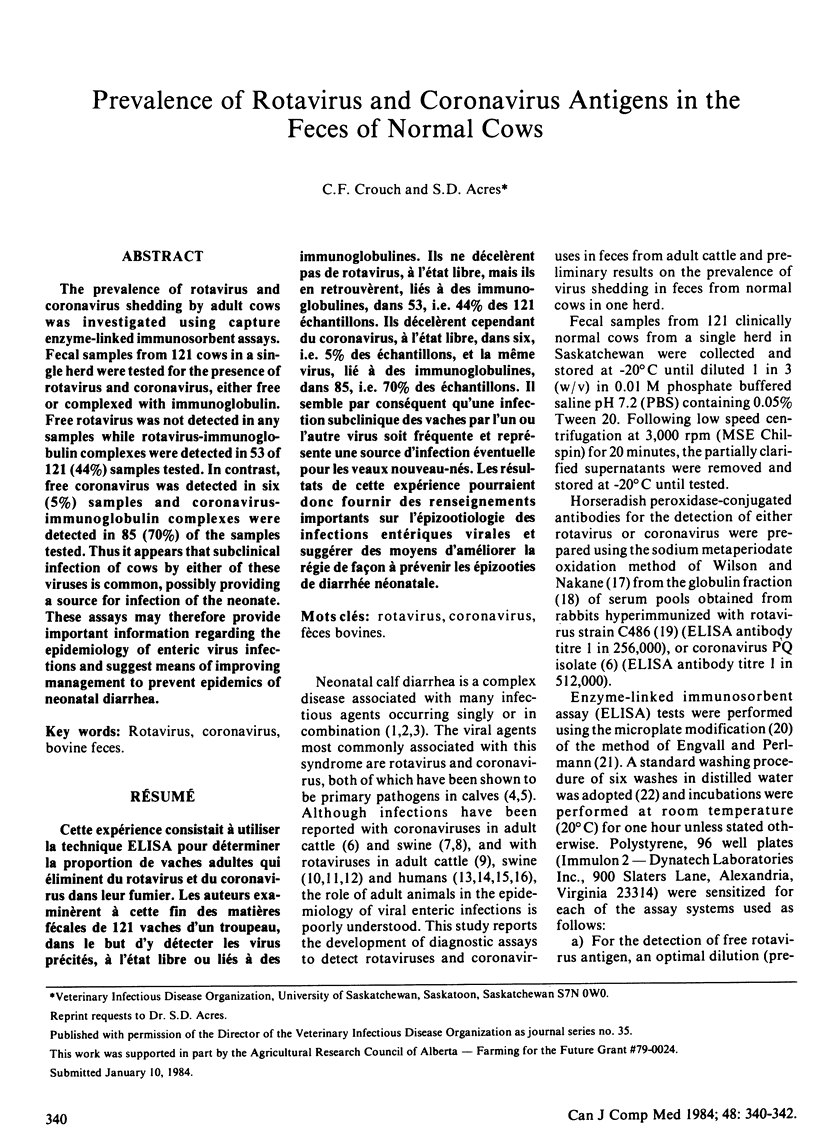Abstract
The prevalence of rotavirus and coronavirus shedding by adult cows was investigated using capture enzyme-linked immunosorbent assays. Fecal samples from 121 cows in a single herd were tested for the presence of rotavirus and coronavirus, either free or complexed with immunoglobulin. Free rotavirus was not detected in any samples while rotavirus-immunoglobulin complexes were detected in 53 of 121 (44%) samples tested. In contrast, free coronavirus was detected in six (5%) samples and coronavirus-immunoglobulin complexes were detected in 85 (70%) of the samples tested. Thus it appears that subclinical infection of cows by either of these viruses is common, possibly providing a source for infection of the neonate. These assays may therefore provide important information regarding the epidemiology of enteric virus infections and suggest means of improving management to prevent epidemics of neonatal diarrhea.
Full text
PDF


Selected References
These references are in PubMed. This may not be the complete list of references from this article.
- Acres S. D., Babiuk L. A. Studies on rotaviral antibody in bovine serum and lacteal secretions, using radioimmunoassay. J Am Vet Med Assoc. 1978 Sep 1;173(5 Pt 2):555–559. [PubMed] [Google Scholar]
- Benfield D. A., Stotz I., Moore R., McAdaragh J. P. Shedding of rotavirus in feces of sows before and after farrowing. J Clin Microbiol. 1982 Jul;16(1):186–190. doi: 10.1128/jcm.16.1.186-190.1982. [DOI] [PMC free article] [PubMed] [Google Scholar]
- Crouch C. F., Raybould T. J., Acres S. D. Monoclonal antibody capture enzyme-linked immunosorbent assay for detection of bovine enteric coronavirus. J Clin Microbiol. 1984 Mar;19(3):388–393. doi: 10.1128/jcm.19.3.388-393.1984. [DOI] [PMC free article] [PubMed] [Google Scholar]
- Crouch C. F., Raybould T. J. Comparison of different antigen preparations as substrates for use in passive hemagglutination and enzyme-linked immunosorbent assays for detection of antibody against bovine enteric coronavirus. J Clin Microbiol. 1983 Jul;18(1):146–149. doi: 10.1128/jcm.18.1.146-149.1983. [DOI] [PMC free article] [PubMed] [Google Scholar]
- Engvall E., Perlmann P. Enzyme-linked immunosorbent assay, Elisa. 3. Quantitation of specific antibodies by enzyme-labeled anti-immunoglobulin in antigen-coated tubes. J Immunol. 1972 Jul;109(1):129–135. [PubMed] [Google Scholar]
- Kemeny L. J. Isolation of transmissible gastroenteritis virus from pharyngeal swabs obtained from sows at slaughter. Am J Vet Res. 1978 Apr;39(4):703–705. [PubMed] [Google Scholar]
- McNulty M. S. Rotaviruses. J Gen Virol. 1978 Jul;40(1):1–18. doi: 10.1099/0022-1317-40-1-1. [DOI] [PubMed] [Google Scholar]
- Mebus C. A., Stair E. L., Rhodes M. B., Twiehaus M. J. Pathology of neonatal calf diarrhea induced by a coronavirus-like agent. Vet Pathol. 1973;10(1):45–64. doi: 10.1177/030098587301000105. [DOI] [PubMed] [Google Scholar]
- Moon H. W., McClurkin A. W., Isaacson R. E., Pohlenz J., Skartvedt S. M., Gillette K. G., Baetz A. L. Pathogenic relationships of rotavirus, Escherichia coli, and other agents in mixed infections in calves. J Am Vet Med Assoc. 1978 Sep 1;173(5 Pt 2):577–583. [PubMed] [Google Scholar]
- Morin M., Larivière S., Lallier R. Pathological and microbiological observations made on spontaneous cases of acute neonatal calf diarrhea. Can J Comp Med. 1976 Jul;40(3):228–240. [PMC free article] [PubMed] [Google Scholar]
- Orstavik I., Haug K. W., Sovde A. Rotavirus-associated gastroenteritis in two adults probably caused by virus reinfection. Scand J Infect Dis. 1976;8(4):277–278. doi: 10.3109/inf.1976.8.issue-4.12. [DOI] [PubMed] [Google Scholar]
- Rodak L., Babiuk L. A., Acres S. D. Detection by radioimmunoassay and enzyme-linked immunosorbent assay of coronavirus antibodies in bovine serum and lacteal secretions. J Clin Microbiol. 1982 Jul;16(1):34–40. doi: 10.1128/jcm.16.1.34-40.1982. [DOI] [PMC free article] [PubMed] [Google Scholar]
- Rodriguez W. J., Kim H. W., Brandt C. D., Yolken R. H., Richard M., Arrobio J. O., Schwartz R. H., Kapikian A. Z., Chanock R. M., Parrott R. H. Common exposure outbreak of gastroenteritis due to type 2 rotavirus with high secondary attack rate within families. J Infect Dis. 1979 Sep;140(3):353–357. doi: 10.1093/infdis/140.3.353. [DOI] [PubMed] [Google Scholar]
- Sabara M., Deregt D., Babiuk L. A., Misra V. Genetic heterogeneity within individual bovine rotavirus isolates. J Virol. 1982 Dec;44(3):813–822. doi: 10.1128/jvi.44.3.813-822.1982. [DOI] [PMC free article] [PubMed] [Google Scholar]
- Underdahl N. R., Mebus C. A., Stair E. L., Rhodes M. B., McGill L. D., Twiehaus M. J. Isolation of transmissible gastroenteritis virus from lungs of market-weight swine. Am J Vet Res. 1974 Sep;35(9):1209–1216. [PubMed] [Google Scholar]
- Voller A., Bidwell D. E. A simple method for detecting antibodies to rubella. Br J Exp Pathol. 1975 Aug;56(4):338–339. [PMC free article] [PubMed] [Google Scholar]
- Wenman W. M., Hinde D., Feltham S., Gurwith M. Rotavirus infection in adults. Results of a prospective family study. N Engl J Med. 1979 Aug 9;301(6):303–306. doi: 10.1056/NEJM197908093010604. [DOI] [PubMed] [Google Scholar]
- Woode G. N., Bridger J. C. Viral enteritis of calves. Vet Rec. 1975 Jan 25;96(4):85–88. doi: 10.1136/vr.96.4.85. [DOI] [PubMed] [Google Scholar]
- von Bonsdorff C. H., Hovi T., Mäkelä P., Mörttinen A. Rotavirus infections in adults in association with acute gastroenteritis. J Med Virol. 1978;2(1):21–28. doi: 10.1002/jmv.1890020105. [DOI] [PubMed] [Google Scholar]


